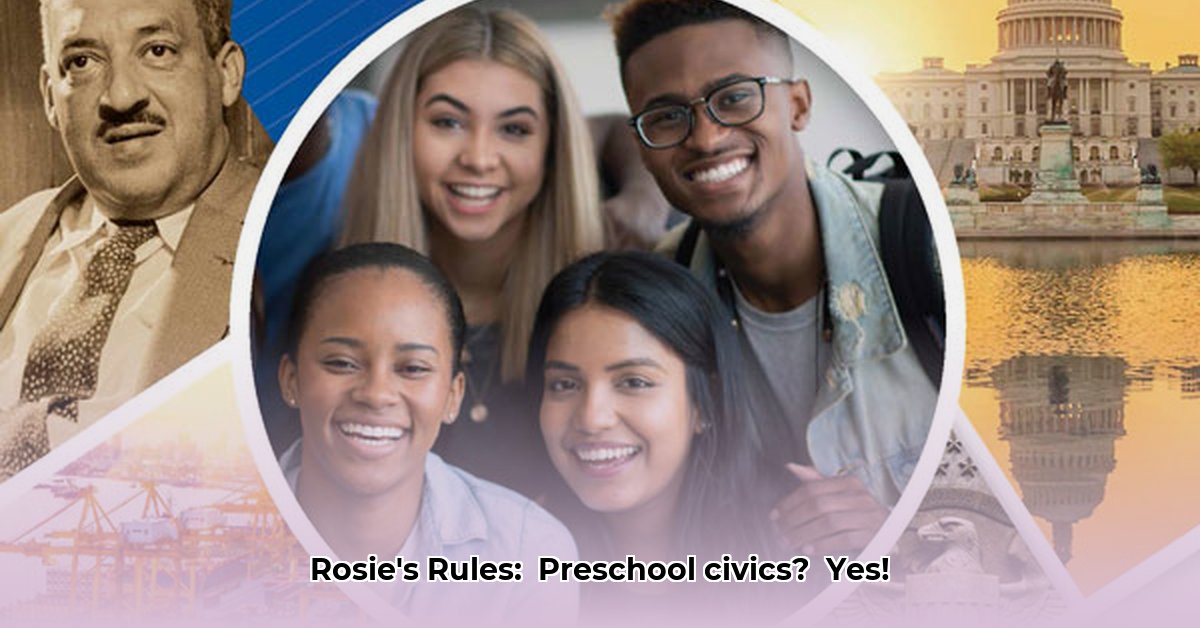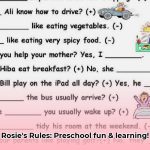Ever wonder how to effortlessly weave essential life lessons into your preschooler’s screen time? PBS Kids’ Rosie’s Rules accomplishes precisely that, teaching children about civics – good neighborliness, community assistance, and comprehension of community functions – all while maintaining a high level of engagement. Learn more about Rosie’s Rules here. This article will examine how Rosie’s Rules effectively imparts these lessons, featuring specific examples from the show and discussing its merits. We’ll also provide suggestions for leveraging the show to further your child’s learning, analyzing this bilingual program and its contributions in shaping young minds into responsible citizens. Learn how Rosie’s Rules integrates early childhood education and preschool social skills, with a focus on community and citizenship.
Examining the Essence of Civics Education in Rosie’s Rules
Rosie’s Rules distinguishes itself from typical preschool programs by uniquely teaching principles of responsible citizenship, going beyond simple rules to explore the “why” behind them. A distinguishing feature is portraying a family with mixed cultures—a Mexican-American father from Mexico City and a mother from rural Wisconsin. This culturally rich blend introduces children to the beauty of diverse communities and encourages appreciation for cultural differences. This is cultural awareness in action, fostering empathy and understanding.
Reflect on the frequency of such family depictions in children’s programming. Rosie’s Rules stands out by representing a family dynamic often absent from the screen, creating an inclusive environment that supports the acquisition of knowledge about the surrounding world. This diversity in media helps children connect civics to real-world contexts, making the lessons more relatable and impactful. The show intentionally highlights both heritages, showcasing the art, traditions, food, and music of the Southwest, Midwest, and Mexico.
The Power of Play: Rosie’s Adventures in Teaching Community Values
Instead of relying on conventional methods, Rosie’s Rules integrates lessons on good citizenship into its storylines through relatable scenarios. Whether Rosie is helping guide a recycling truck around town, watering the community garden, or aiding her neighbor in planting flowers, reinforcing the importance of kindness and community spirit, or learning library rules, underscoring the necessity of order and respect, the show transforms education into a delightful adventure. These episodes avoid lecturing and instead engage viewers with Rosie’s exciting experiences. Rosie’s Rules is a preschool curriculum goldmine, offering valuable lessons wrapped in engaging entertainment.
The show also adeptly manages cultural differences. A visit to a Mexican festival becomes a lesson in celebrating diverse traditions and appreciating varied forms of celebration. The key is demonstration, not didacticism. The series emphasizes that heritages come into play in everyday life and that Rosie is proud of this heritage.
Unpacking the Effectiveness of Rosie’s Rules: A Deep Dive into Character Development
The brilliance of the show’s creators lies in their skillful integration of civics into the stories, so seamlessly that young viewers may not even notice they’re learning. Remember Rosie’s Rules? These aren’t arbitrary edicts but concise summaries of vital civic concepts such as cooperation, support, and respect, all presented in an engaging and comprehensible way. This demonstrates intelligent design principles and a deep understanding of how preschoolers acquire knowledge. This is early childhood development done right, ensuring that lessons are both educational and entertaining.
Here’s how different civic concepts are taught:
- Teamwork: Helping her family build a birdhouse teaches the value of cooperation in achieving collective goals, demonstrating how everyone’s contribution matters.
- Respect for Rules: Learning the rules for playing in the park demonstrates why rules are crucial for safety and fairness, fostering an understanding of structure and order.
- Community Spirit: Rosie engages in neighborhood cleanup, teaching children that contributing makes a community better, instilling a sense of responsibility and pride.
- Cultural Appreciation: Attending a town parade shows the beauty of different local cultures, nurturing an open-mindedness and respect for diversity.
- Understanding Different Dwellings: An episode about homes versus apartments shows children different perspectives on living arrangements.
Delving into Strengths and Potential: Critical Analysis of Children’s Programming
Rosie’s Rules has achieved immense success. Parents and kids alike are drawn to the relatable characters and entertaining stories. This educational entertainment effectively highlights cultural diversity, a notable absence in many children’s programs. One parent noted, “That’s my family,” showing how the show resonates with viewers.
However, despite the positive reception, long-term data on the show’s lasting impact remains limited. Researchers are actively examining this. Furthermore, broadening the show’s distribution—through streaming platforms or multilingual options—could substantially amplify its influence. The show has already produced eighty 11-minute episodes, with each story tested by kids ages 3 to 6, plus their parents, to make sure the stories are engaging and the curriculum is appropriate.
The Future of Civics: Expanding Impact of Early Childhood Education
Rosie’s Rules holds substantial potential for educating preschoolers in civics through its engaging and effective method. To fully assess its long-term influence, more research is essential, to track the carry over effect of the show. Further studies should investigate how well children retain and apply the lessons presented. Broadening its accessibility both nationally and internationally will greatly enhance its impact. Lastly, developing supplementary educational materials, such as workbooks or online games, could extend learning beyond the screen. By prioritizing these areas, Rosie’s Rules can significantly contribute to shaping future generations of responsible citizens.
How to Use Rosie’s Rules for Preschool Social Studies Curriculum
Key Takeaways:
- Rosie’s Rules effectively weaves social studies into engaging narratives with relatable characters.
- The show’s bicultural aspect enhances its relevance and appeal for children.
- While initial reception is positive, long-term impact data needs further study.
- Utilizing Rosie’s Rules requires a thoughtful approach by parents and educators.
A Practical Guide for Educators to Instill Social Awareness in Preschool
Rosie’s Rules offers a valuable opportunity for teaching preschoolers essential concepts in social studies. How can educators effectively integrate it into their curriculum?
Integrating Rosie’s Rules into the Classroom
- Select Relevant Episodes: Align the episodes with your specific teaching objectives. The show addresses themes from community involvement to cultural understanding. Consider episodes that focus on civics and government, geography, economics, and history.
- Pre-Viewing Activities: Discuss the characters and setting to pique interest, preview images, and discuss key vocabulary to improve comprehension. Engage the children by discussing what they already know about the topics to contextualize the lesson.
- Interactive Viewing: Encourage participation during viewing. Pause to ask open-ended questions like, “How did Rosie show kindness?” or “What problem did the community face?” This encourages critical thinking. Have the children guess what Rosie’s Rule will be at the end.
- Post-Viewing Discussions: Discuss lessons from each episode. Engage children by asking about motivations, solutions, and differences. Use art work, role-playing, or even building to reinforce what they learned.
- Extension Activities: Rosie’s Rules provides a foundation for follow-up activities using storybooks, projects, or group activities to solidify lessons. Create your own “Let’s Vote Bingo” activity, vote for a favorite fruit, and have the children count the votes.
Strengths and Limitations: Evaluating Educational Programs
Strengths:
- Engaging Narratives: Through relatable stories the show connects with children. Simple storytelling makes complex ideas accessible. The writers intentionally instill emotion behind every action, like Rosie’s cat’s “meow.”
- Bicultural Representation: The bicultural approach teaches diverse perspectives and cultures, leading to enhanced understanding of the world.
- Integrated Curriculum: Social studies concepts are smoothly woven into narratives. It’s a natural way for learning.
Limitations:
- Limited Long-Term Data: Further studies are needed to prove its long-term effectiveness on social studies understanding. Testing needed!
- Accessibility Concerns: The creators might need to address representational issues to ensure accessibility for children from all backgrounds.
Maximizing Educational Impact by Teaching Preschool Social Studies
To fully utilize Rosie’s Rules, remember effective implementation requires planning. Select age-appropriate episodes, incorporate pre- and post-viewing activities, and connect the show’s lessons to real-world scenarios. Rosie’s Rules is a tool that requires thoughtfulness to inspire curiosity and shape responsible future citizens.
Rosie’s Rules vs. Other Educational Shows: A Comparative Analysis for Children’s Media
Key Takeaways:
- Rosie’s Rules uniquely blends cultural representation, curriculum, and comedy for preschool learning. This is great children’s media.
- The show integrates civics within engaging narratives.
- Its bilingual format offers language learning opportunities.
- The show’s success depends on continued viewership and research.
- Comparing Rosie’s Rules to other educational shows, its commitment to diverse representation differentiates it.
Rosie’s Unique Civics Curriculum and Bilingual Education
*Rosie
- The Accidental Breakthrough: Penicillin’s Discovery and Impact - August 1, 2025
- Medieval Universities: Shaping Modern Academia - August 1, 2025
- The Radium Girls: Workplace Safety Lessons from a Tragic Past - August 1, 2025















